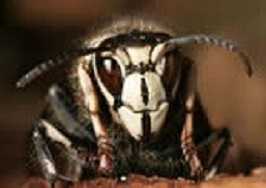INSECTS AND SCORPIONS
Bees, Wasps, and Hornets
Bees, wasps, and hornets are most abundant in the warmer months. Nests and hives may be found in trees, under roof eaves, or on equipment such as ladders.
U.S. Geographic Region
Bees, wasps, and hornets are found throughout the United States.
Employer Recommendations
Employers should protect their workers from stinging insects by training them about:
- Their risk of exposure
- Insect identification
- How to prevent exposure
- What to do if stung
Worker Recommendations
Workers should take the following steps to prevent insect stings:
- Wear light-colored, smooth-finished clothing.
- Avoid perfumed soaps, shampoos, and deodorants.
- Don't wear cologne or perfume.
- Avoid bananas and banana-scented toiletries.
- Wear clean clothing and bathe daily. (Sweat may anger bees.)
- Wear clothing to cover as much of the body as possible.
- Avoid flowering plants when possible.
- Keep work areas clean. Social wasps thrive in places where humans discard food.
- Remain calm and still if a single stinging insect is flying around. (Swatting at an insect may cause it to sting.)
- If you are attacked by several stinging insects at once, run to get away from them. (Bees release a chemical when they sting, which may attract other bees.)
- Go indoors.
- A shaded area is better than an open area to get away from the insects.
- If you are able to physically move out of the area, do not to attempt to jump into water. Some insects (particularly Africanized Honey Bees) are known to hover above the water, continuing to sting once you surface for air.
- If a bee comes inside your vehicle, stop the car slowly, and open all the windows.
- Workers with a history of severe allergic reactions to insect bites or stings should consider carrying an epinephrine auto injector (EpiPen) and should wear a medical identification bracelet or necklace stating their allergy.
First Aid
If a worker is stung by a bee, wasp, or hornet:
- Have someone stay with the worker to be sure that they do not have an allergic reaction.
- Wash the site with soap and water.
- Remove the stinger using gauze wiped over the area or by scraping a fingernail over the area.
- Never squeeze the stinger or use tweezers.
- Apply ice to reduce swelling.
- Do not scratch the sting as this may increase swelling, itching, and risk of infection.
- Page last reviewed: July 1, 2016
- Page last updated: July 1, 2016
- Content source:
- National Institute for Occupational Safety and Health Education and Information Division


 ShareCompartir
ShareCompartir
